This is a Thai green curry paste recipe made from scratch! The beauty of a homemade green curry paste is that you can control the spiciness without compromising any of the beautiful fragrant flavour and signature green colour.
Use it now to make Thai Green Curry – or keep it for later!
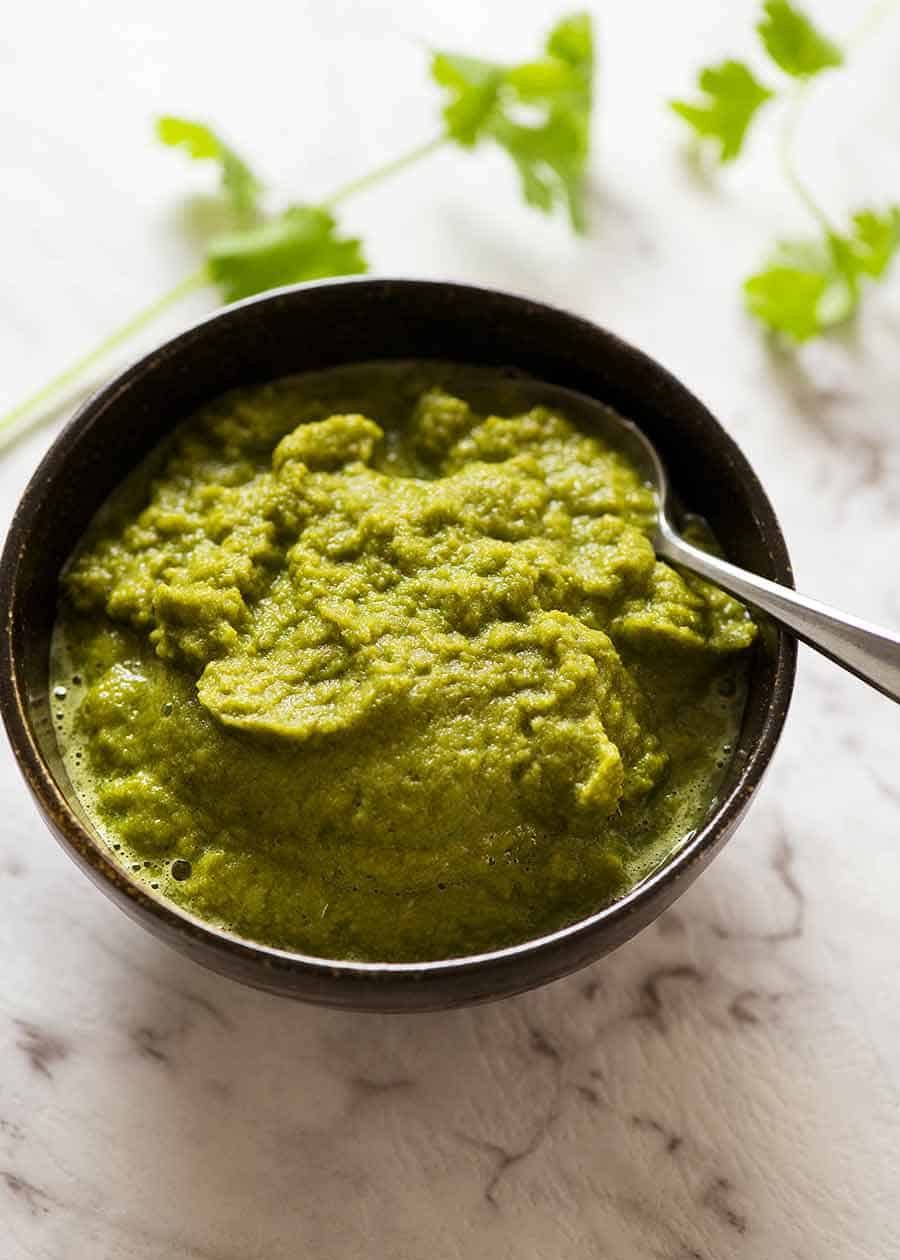
Thai Green Curry Paste recipe!
Usually, the main reason to make curry paste yourself is because you just can’t get the same intense, fresh flavour in a jar. And while that holds true for green curry paste, the other very big advantage is that you can control the spiciness without compromising flavour or the signature green colour.
You can’t do that if you buy curry in a jar. You make do with what you get – and if you use less to reduce the spiciness, that means diluting the curry flavour.
As with all curry pastes like Thai Red Curry Paste, Thai Yellow Curry and Massaman Curry Paste, actually making the this green curry paste recipe is very straight forward – just plonk and blitz until smooth.
The part that takes the longest is gathering the ingredients – though it you’ve got an Asian grocery store nearby, it will be a breeze!

I don’t usually make it a habit to go through every ingredient in a recipe, but given there are a few in this that are not so main-stream, I thought it might be helpful! So here we go – let’s start with the most important:
Green Chillies
The colour of green curry comes from green cayenne peppers (left, large), and the spiciness comes from the little Thai green chillies (right). They might be small, but they pack serious heat!
For a very mild curry, skip the Thai chillies altogether.
For a mild curry, just use 1 Thai chilli.
For pretty spicy but not “blow your head off” (aka David Thompson’s Long Chim), use 6 Thai chillies per the recipe. I enjoy it without swearing and I’m a spice wuss! (Though I like to think I’m Chilli-tough, I’m not at all.)

Dried Shrimp Paste (Belachan / Belacan)
Fermented fish and shrimp flavours are the backbone of South East Asian cuisine and Thai Green Curry is no exception.
For Thai Red Curry Paste, we like to use shrimp paste in a jar which is oilier and has a few more flavourings added. However, if you use shrimp paste in green curry, it makes it brown!
Hence we use dried shrimp. It comes in little blocks, it stinks and it’s hard to believe it’s the secret ingredient in Thai Green Curry.
But it is. If you skip it, you will be disappointed with the end result.
Find it at Asian grocery stores and if you’re in Australia, you won’t believe this but it’s sold at Woolworths! And here is one on Amazon US.
Best substitution for dried shrimp?
Shrimp paste (comes in jars, photo here) is the best sub but note it makes the curry a bit less green. The other alternative (which I haven’t tried but I think will be very good) is to use anchovies in oil (chop and measure amount per recipe) + 1 tsp fish sauce (for extra depth of flavour).
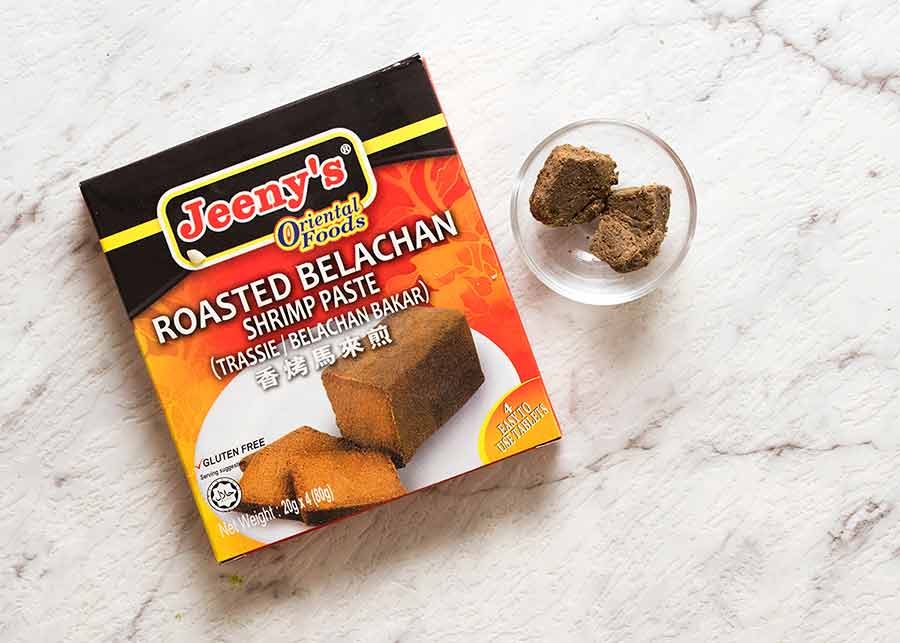
Galangal
Looks like ginger with red skin, but it’s way harder. It kind of tastes like ginger too, but it’s more citrusy.
Nowadays in Australia it’s sold at large fresh produce stores like Harris Farms, and sometimes even at Woolworths. Otherwise, it’s readily available at Asian grocery stores.
As a last resort, it can be substituted with ginger and lime zest – directions in the recipe notes.

Lemongrass
Moving onto more familiar territory here! Lemongrass is a key flavour in green curry paste and you can’t substitute paste or dried for fresh lemongrass.
To prepare, peel the outer reedy layers to reveal the white stem, and just use the lowest 10 cm / 4″ or so. You’ll know which part should be used because the reedy part can’t be chopped.

Eschalots (Baby Onions!)
The names for this are so confusing so I wanted to show a picture to be very clear! In Australia, we call these eschalots or French shallots or French onions. In America, they are known as shallots. In Australia, shallots are what Americans know as scallions or green onions, as does much of Europe.
It’s very confusing.
Hence – photo. Green curry paste calls for the thing that looks like BABY ONIONS!!
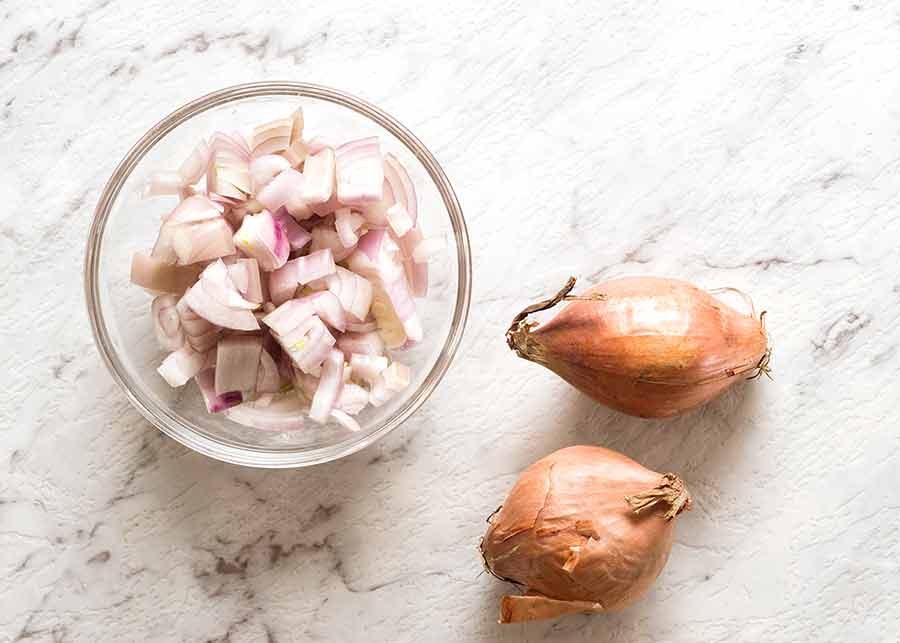
Coriander / cilantro, lime and garlic
Traditional Thai Curry Pastes are mostly made with coriander/cilantro roots. The roots have intense coriander flavour that’s sort of earthy.
Because the roots are so highly prized in Thai cooking, coriander is sold with long roots in Thai grocery stores. Unfortunately in Western grocery stores, the roots tend to be quite short and dismal.
They are also a massive pain to wash thoroughly – no one wants dirt grit in their curry!
So to get around this problem, we use a combination of whatever roots we can get, stems and some leaves (which has the added bonus of adding to the lovely green colour!)
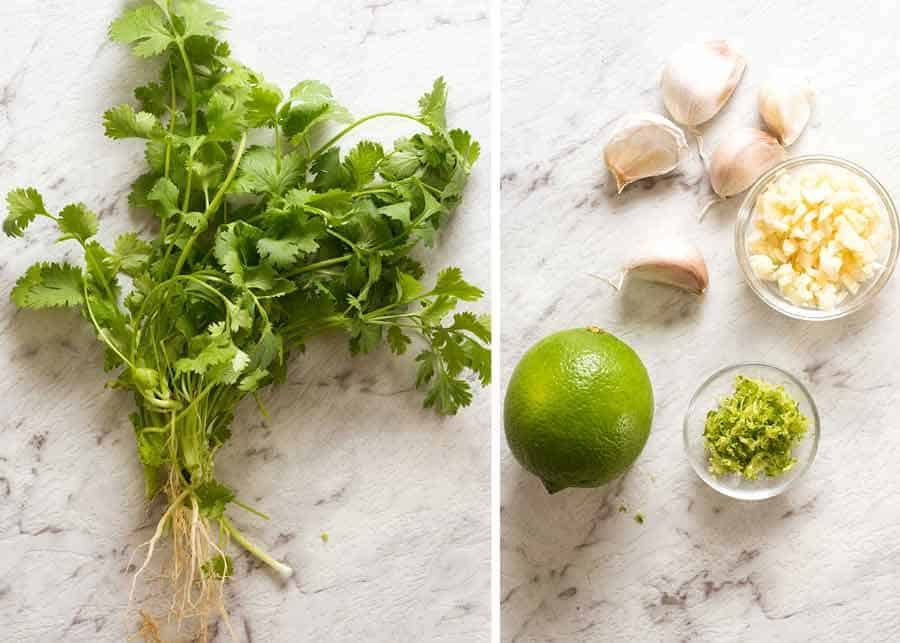
Green Curry Spices
Green curry is mostly about the intense fresh aromatics so there’s not much dried spices in it. If you Dom’t have white pepper, switch it with finely ground black pepper. Don’t skip the tumeric – as well as adding flavour, it is the ingredient that gives the green curry paste a beautiful warm glow!

Making the green curry paste
Once the ingredients are ready to go, just blitz in a blender or a powerful food processor.
The smoother you can make the paste the better – nobody wants gritty bits of galangal or lemongrass in their otherwise silky curry sauce!
This is the reason I opt to use a blender – because I find it does a better job of blitzing all the ingredients into a smooth paste. I’ve noticed Asian chefs on cooking shows use blenders as well.
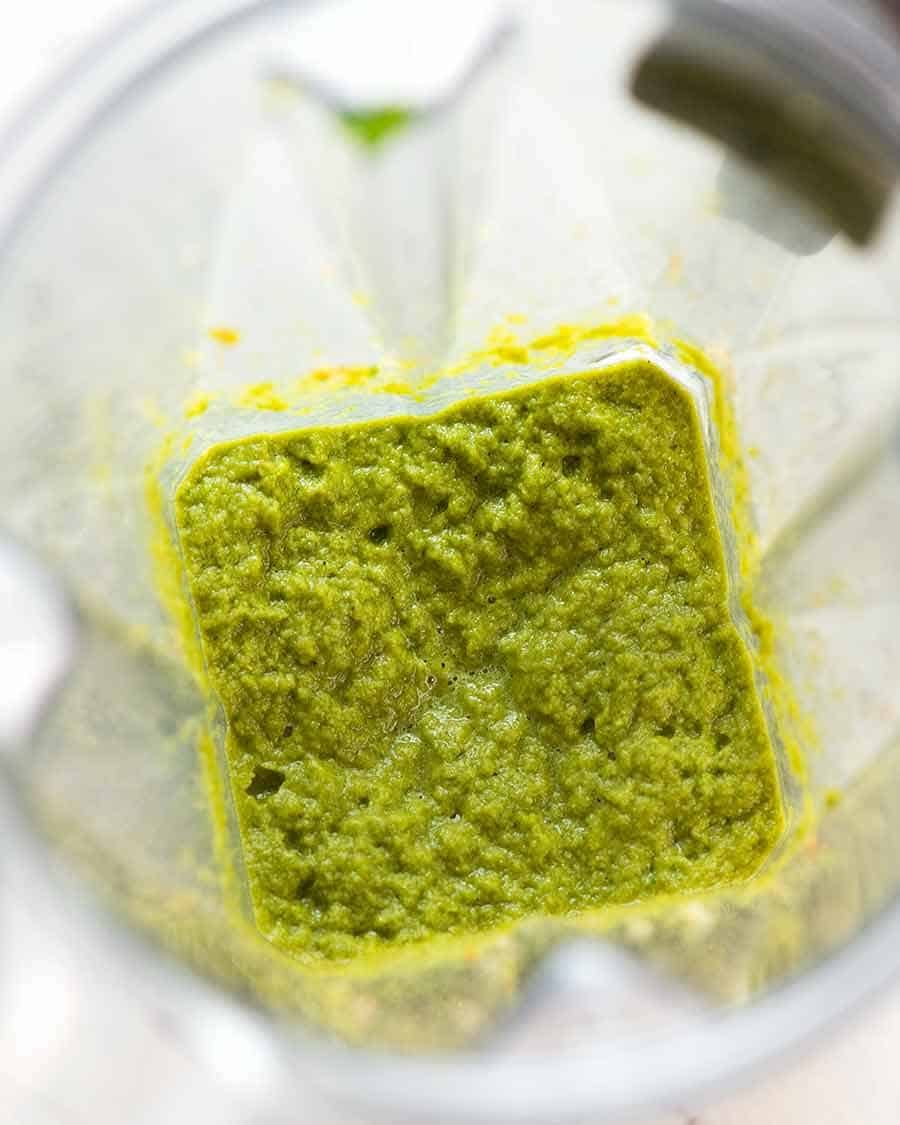
How to store curry paste
A fresh curry paste made with aromatic herbs like this one is best used immediately. Otherwise, store it in an airtight container for 2 days in the fridge, or up to 1 month in the freezer. From a food safety point of view, even 3 months is fine but I swear it starts losing flavour after about 1 month (I could be imagining things!).
What to use Green Curry Paste for
The most obvious use for Green Curry Paste is to make Thai Green Curry which I have also shared today. If you’ve ever had a really great Thai Green Curry either outside of Thailand, or even better, in Thailand itself, I think you’ll really enjoy this!
Here are some either ways to use green curry paste:
Fried Rice – fry a little paste in oil then proceed with your favourite Fried Rice recipe. Thai GREEN CURRY Fried rice!!
Spice up soups – Fry a little paste in oil then proceed to make your favourite soup. Imagine – green curry spiced Cauliflower Soup or Broccoli Soup!
Stir Fries – fry a little paste in oil then proceed to make your favourite stir fry.
Soup – Dilute the curry sauce in the Thai Green Curry with more chicken or vegetable broth and more coconut milk to make a SOUP broth!
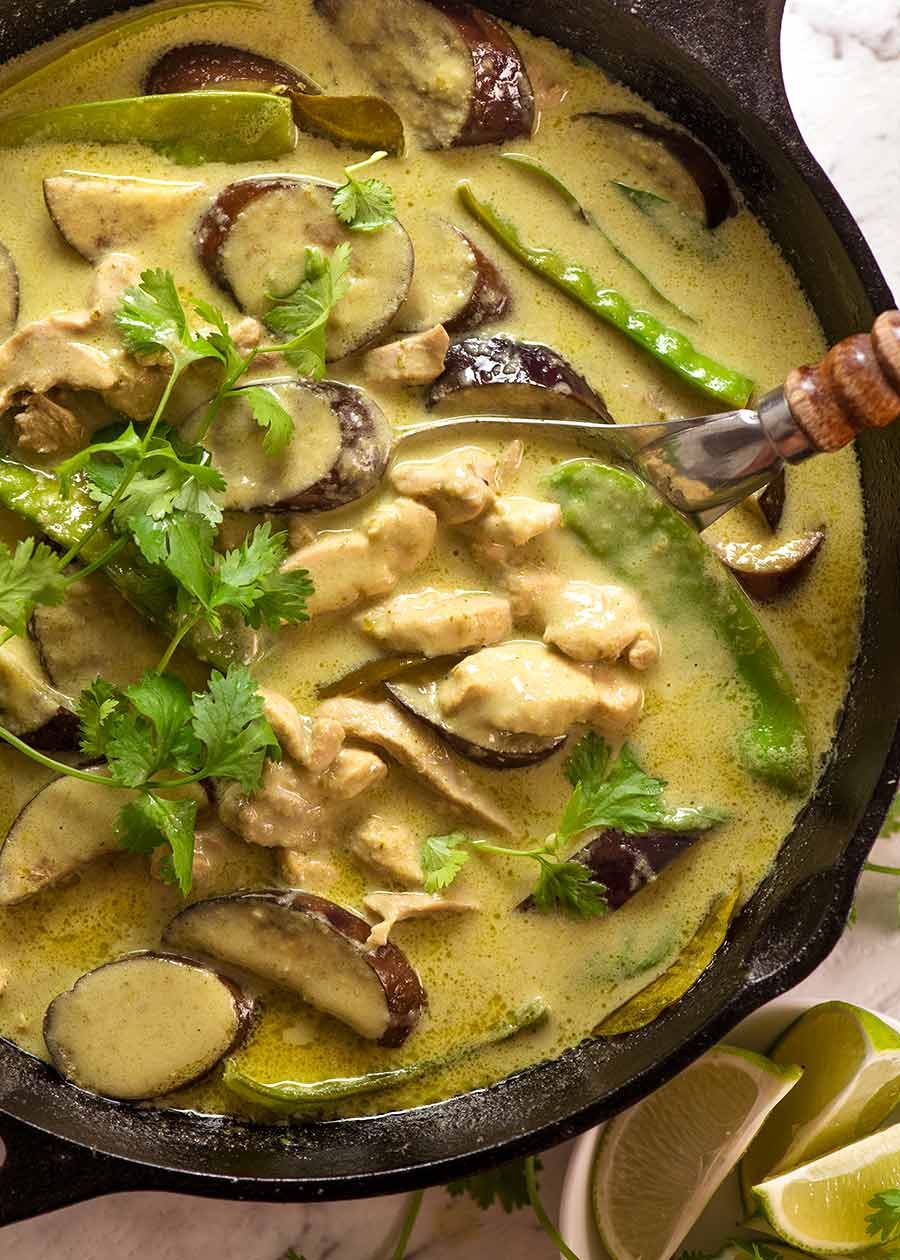
Before I sign off, I just want to say that while curry in a jar lacks the same freshness of homemade, you can still make a terrific Green Curry by pimping up a store bought curry paste with fresh garlic, ginger and lemongrass. You’ll find the directions in the Thai Green Curry recipe, along with my recommendation for the BEST curry in a jar (and it’s the cheapest too!) – Nagi x

Homemade Thai Green Curry Paste
Watch how to make it
Video coming shortly! It literally is plonk and blitz. Video to make the curry is in the Thai Green Curry recipe.
Hungry for more? Subscribe to my newsletter and follow along on Facebook, Pinterest and Instagram for all of the latest updates.

Homemade Thai Green Curry Paste
Ingredients
- 4 green cayenne pepper chilis , deseeded and chopped (Note 1)
- 6 Thai green chilis , chopped (Note 1)
- 2 red shallots / eschallots , chopped
- 2 lemongrass stems , trimmed and finely chopped (about 2.5 – 3 tbsp) (Note 2)
- 2 tbsp galangal , grated (Note 3)
- 5 cloves garlic , chopped
- 2.5 tsp dried shrimp paste (Belacan) (Note 4)
- 2 tsp lime zest , grated
- 1 tsp ground coriander
- 1 tsp ground cumin
- 1/4 tsp white pepper
- 1/4 tsp turmeric
- 2 tbsp chopped coriander/cilantro root and stem (Note 5)
- 1/4 cup coriander / cilantro leaves , loosely packed
- 2 – 3 tbsp water , as needed
Instructions
- Combine all ingredients except water in a powerful blender or food processor. I use my Vitamix because it makes the paste smoother.
- Blend to a fine paste, scraping down the sides as you go. Add the water as required to help it blend (you may not need any as the herbs and chilis have moisture).
- Use to make Thai Green Curry!
- Best to use immediately. Otherwise, refrigerate for up to 2 days, or freeze for 1 month.
Recipe Notes:
Nutrition Information:
Life of Dozer
Torturing a blue tongue lizard (the very existence of which tortures me!)
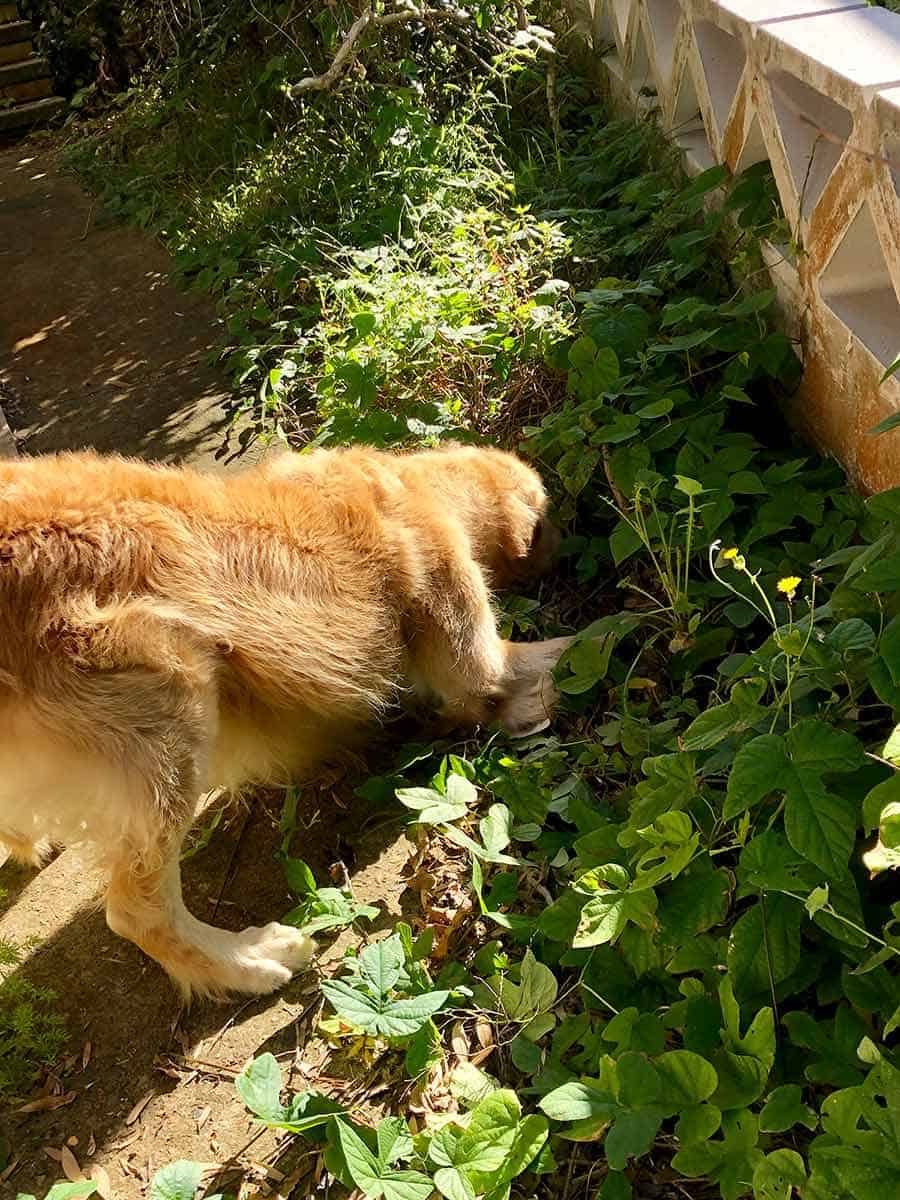
Hey Nagi, my wife and I made this a month ago, and it was awesome!!! Best green curry we’ve ever made!!! We did use jalapenos instead of cayenne and substituted the shrimp paste(bc we couldn’t find the dry ones here) for a high end fish sauce (Red Boat), and it was still awesome!!! Thank you so much for the recipe! We will definitely be using this one again!
I’m so glad it was a hit Kao, thanks so much for letting me know!
Hi,Naig!
It was a perfectly balanced curry, not too sweet, not too salty, I followed your thai curry paste from the scratch and it was great! only problems is that I didn’t were gloves when I scraped seeds from chilies and I am suffering from my burning feeling from my fingers:(
Oh no, gloves next time for sure! I’m so glad you liked the curry though – I hope it was worth the burning fingertips 😬
Another tip, if you don’t want to use gloves is coat y0ur hands in cooking oil. The barrier of the oil stops the peppers getting into your skin. I have done this for about 15 yrs with no problems.
Or use a small spoon to scrape the seeds out
Hi nagi! My brother is allergic to shrimp. What should I do instead?
Hi Sarah, is he ok with fish?
I’m hijacking this post! I’m allergic to shrimp but can have fish – what would you suggest as a substitute?
OK I’m confused about the cayenne pepper thing…
https://upload.wikimedia.org/wikipedia/commons/thumb/3/32/Thai_peppers.jpg/440px-Thai_peppers.jpg
That picture is labelled as Thai Peppers a type of Cayenne Pepper
The cayenne pepper is a type of Capsicum annuum. It is usually a moderately hot chili pepper used to flavor dishes. Cayenne peppers are a group of tapering, 10 to 25 cm long, generally skinny, mostly red-colored peppers, often with a curved tip and somewhat rippled skin, which hang from the bush as opposed to growing upright. Most varieties are generally rated at 30,000 to 50,000 Scoville units.[1]
Is this cayenne green pepper the same as what we call the “jalepeno pepper” in the United States?
No, The Jalapeno is shorter and plumber, while the Cayenne is long and thin.
The green curry looks delicious. Since I am a vegetarian, is there anything I could substitute for the shrimp paste? I know you said it would be disappointing if one left it out, but I thought I’d ask anyway to see if you had any suggestions. Thanks.
I’d like to know the answer to this too, as I am allergic to crustaceans! Love all your recipes Nagi
I’d love to know the answer to the question about shrimp paste too, as I am allergic to crustaceans.
I love all your recipes Nagi!
I can’t have garlic, could I make it without? or is a substitute?
Hi Bec! Garlic is pretty key in curries, but can you do eschallots? ie French shallots – those small baby onions. If you can, then use one of those instead 🙂 N x
I have been waiting for this moment for months! I’ve made the red curry paste like 10 times!
Yesssss! I hope you love it!
What if I can’t find any green cayenne where I’m at? Can I sub another green pepper like serrano? Thanks.
Yes. The same for me
Hi Kao, just check the heat as Serrano are hotter than cayenne – N x